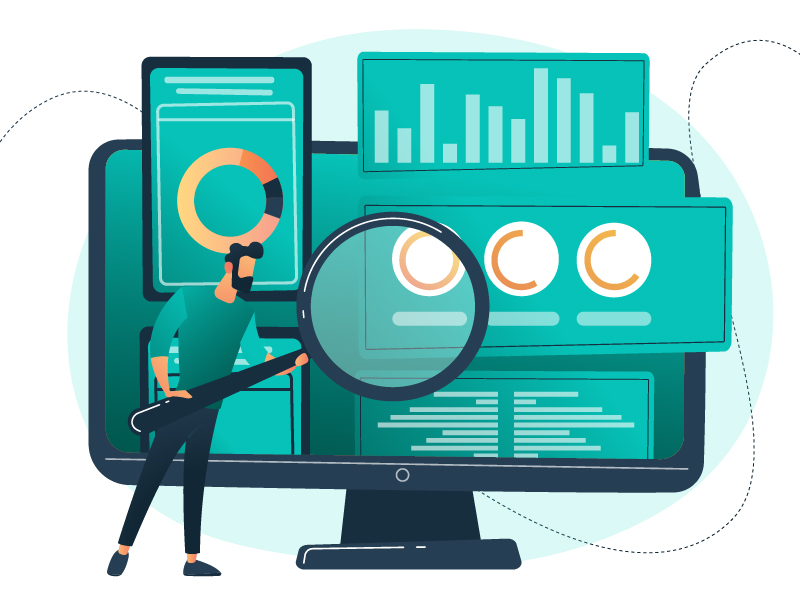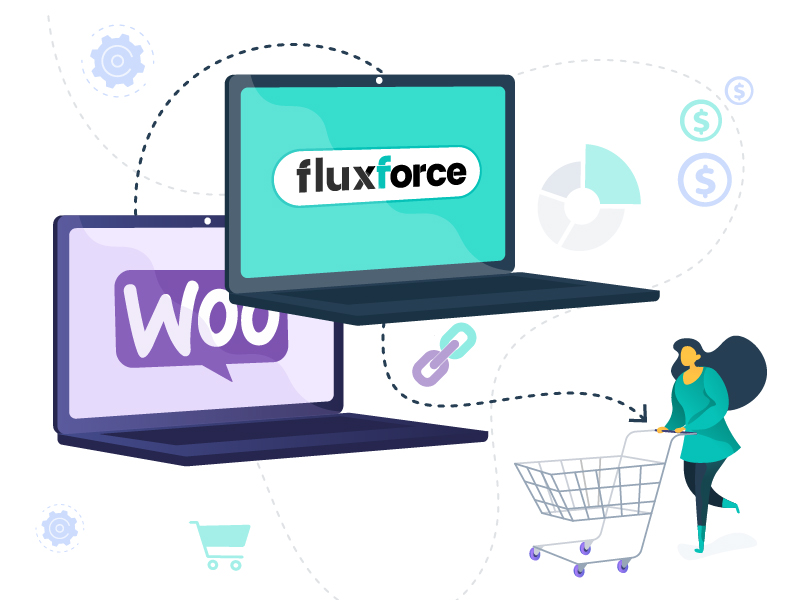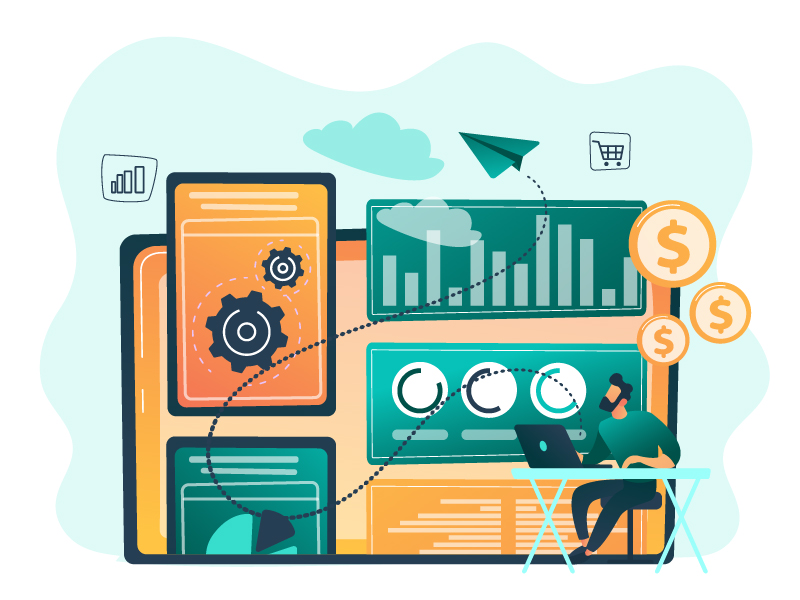A compilation of the most common terms used by teams and specialists to address topics related to digital marketing and automation.
Segmentation, gamification, responsive web design, CTR, PPC… What do these terms and acronyms mean?
The field of digital marketing is an expanding universe; new words and concepts appear each year to name new tools, actions, processes. Whether you’re an executive or an entrepreneur looking to boost your brand through digital marketing, you need to master the unique codes of this field to interact with your team, your clients, the agency managing your communication strategy, etc.
As experts in digital marketing and automation, we’ve prepared this glossary of definitions to provide you with a clear and concise guide that will help you better understand the terms most commonly used in the digital realm.
Marketing Automation: Marketing automation involves the use of technology and software to automate and optimize marketing processes such as email campaigns, lead management, content personalization, etc. This automation enables businesses to deliver relevant and timely messages to potential customers, enhancing the efficiency and effectiveness of marketing strategies.
By using FluxForce to automate your digital marketing, you can incorporate forms and landing pages into your multichannel campaigns, as well as send personalized emails, WhatsApp messages, or SMS, either on a schedule or based on leads’ actions and behavior, such as responding to an email, making online purchases, visiting your company’s website, or others.
Lead Generation: Refers to the process of identifying and attracting individuals interested in a company’s products or services. These “leads” are individuals who have shown interest in the company’s offering by providing their contact information. It often revolves around the concept of exchanging a resource (such as a free eBook) for the customer’s email address or phone number. Lead generation aims to create a database of potential customers who can be nurtured with content and follow-ups to eventually convert them into actual customers.
Users: This term is used to describe anyone who accesses or views your digital assets. In other words, it refers to individuals who visit, browse, and utilize the resources and functionalities of your digital tools. This term can apply to website visitors, social media account followers, mobile app users, and software tool users. In data analysis and marketing strategies, understanding users’ behavior and needs is essential for improving their experience and achieving specific goals.
Market Segmentation: Market segmentation is the process of dividing a broad market into smaller, homogeneous groups of consumers with similar characteristics and needs (demographic, geographic, psychographic, or behavioral). This term also applies to the process of tailoring a marketing campaign to focus on a smaller group of users within a unique category.
Funnel: A purchase funnel is a conceptual model that represents the process a potential customer follows from becoming aware of a product or service to ultimately making a purchase. The funnel consists of various stages, such as awareness, interest, consideration, decision, and action, reflecting how consumers progress through these stages while making informed purchase decisions.
Top of the Funnel: Refers to the initial stage of the sales or conversion process in a marketing funnel. In this phase, prospects are still in the early stages of research and exploration. It’s one of the most pivotal stages where the primary goal is to capture the audience’s attention and generate interest. This is achieved by providing educational and valuable content to establish a connection with prospects and move them toward later stages of the conversion funnel.
Email Marketing: Email marketing is one of the pillars of current digital marketing strategies. It involves sending promotional, informative, or relevant messages and content to a list of email addresses of potential or current customers. Its aim is to establish direct communication with the audience, build relationships, and drive conversions. Email marketing can include newsletters, special offers, advertisements, product updates, and more.
B2B: (Business to Business) is a business model where the involved companies create products and services for other businesses and organizations.
B2C: (Business to Consumer) is a business model where a company sells products directly to consumers. “Consumers” here can be defined as the end users.
Affiliate Marketing: Involves promoting another company’s product or service in a way that when a user makes a purchase through your affiliate link, you earn a commission. Advertisers and online publishers divide website revenues based on specific performance metrics (usually, sales, clicks, or completed forms). A prime example of affiliate marketing is food blogs that earn money through ads on the page and conversions from the food blog to retailers.
KPI: A Key Performance Indicator, or KPI, is any metric that a marketer or brand considers vital to their performance. KPIs (Key Performance Indicators) are essential performance metrics used in marketing and business to measure and assess progress toward specific goals. They are quantifiable metrics that enable the evaluation of the success or performance of a strategy, campaign, or process.
Direct Response: Direct response is an advertising method that persuades the audience to take prompt action. In a direct response campaign, you might ask users to subscribe to an email list, for instance. Its aim is to generate an immediate reaction from the customer through calls to action (CTAs), always with a focus on driving a specific behavior or action.
Native Advertising: It is a form of online advertising that seamlessly and non-disruptively integrates into the content and design of the platform where it appears. It blends with the look and style of the environment in which it’s displayed, making it less intrusive. In most countries, this type of ad is required to be clearly labeled as paid content.
On-Page Optimization: Refers to the enhancement and adjustment of specific elements of a web page with the goal of improving its visibility in search engines and user experience. This involves optimizing elements like keywords, meta tags, headings, images, and internal links to enhance ranking in search results and ensure the page is relevant and useful to visitors.
Keyword: Specific terms or phrases that users use to search for information on search engines. In digital marketing, keywords are essential for content and ad optimization, as they help websites and campaigns become more relevant to user searches. Choosing the right keywords is crucial to improving the visibility and traffic of a website or online platform.
Page Views: Refers to the total number of times a page has been viewed by a user. This term is used in web traffic analysis to measure the popularity and reach of a particular page. Each time a user accesses or reloads the page, it’s counted as a page view.
Adaptive Web Design: Most new websites are designed according to adaptive web design or responsive web design standards. It refers to the creation of websites that automatically adjust and adapt to different screen sizes and devices. This ensures that content and design appear correctly on desktop computers, tablets, and mobile phones without the need to create separate versions for each device.
Search Engine Optimization (SEO): It involves a set of practices and techniques used to improve the visibility and ranking of a website in the organic search results of search engines like Google. The goal is to increase the quantity and quality of web traffic by optimizing aspects such as keywords, site structure, high-quality content, and link building.
Search Engine Results Page (SERP): The SERP is the page you get after entering a search query into Google (Bing, Yahoo, DuckDuckGo, or your preferred search engine). The SERP lists links to websites along with titles, descriptions, and other relevant elements. It may also include paid advertisements and featured snippets.
Analytics: This term describes the process of collecting, organizing, and interpreting data related to the performance of a specific communicative product in the digital environment. Tools like Facebook Insights or Google Analytics allow marketing professionals to gather metrics from their website, social media, etc., and adjust the strategy based on the results obtained. FluxForce, as a marketing automation platform, provides a series of metrics related to the performance of campaigns, messages, emails, etc., making it easier to recognize which strategy (actions, timing, channels, message approach, etc.) is more effective.
A/B Testing: One of the most effective strategies for evaluating the performance of a digital action, message, or communication campaign. Essentially, it involves creating two versions of a digital action to determine which is more effective with users. This could be two landing pages, emails, ads, etc. Evaluating the performance of the versions generates data that will show you which version of the content performs better (percentage of people clicking a link, completing a form, or making a purchase).
Return on Investment (ROI): This is a metric that assesses the profitability of an investment. It’s calculated by dividing the gain from the investment by the cost of the investment and expressed as a percentage or decimal value. It’s a vital metric in marketing and business to evaluate the effectiveness of strategies and make informed decisions.
Bounce Rate: The bounce rate measures how many visitors enter your website and leave before viewing another page or interacting with its content in any way. It’s the percentage of visitors who exit the website without completing the desired action. Bounce rate is measured as a percentage, the lower the percentage, the lower the bounce rate, and the better your site’s performance.
Click-Through Rate (CTR): The click-through rate measures the percentage of users who click on a link. CTR is frequently used as a metric in social media and email marketing.
Cost Per Click (CPC): Cost per click is the foundation of much of today’s online advertising. In CPC advertising, marketers pay only for each click rather than being based on user impressions. Most CPC campaigns will automatically shut off when the marketer’s budget is reached unless other settings are in place.
Cost Per Sale (CPS): It’s the alternative to CPC. In a CPS advertising campaign, marketers pay based on how many impressions their ad receives, regardless of whether the user clicks the ad or performs a conversion.
Pay Per Click (PPC): Pay per click is the advertising model conceived by Google, Facebook, and other online advertising platforms. It’s a model where advertisers pay a fee each time a user clicks on their ad. Ads are displayed on search engines, social networks, and other websites. Advertisers only pay a fee when a user clicks on an ad.
Content Management System (CMS): A content management system is any system used to organize the content of a website. Some examples include Squarespace, WordPress, or Wix. A CMS is used to create, manage, and publish content online.
Customer Relationship Management (CRM): A CRM software helps businesses collect, organize, and automate communication with their customers. CRM software is often used for lead generation and automating communication with current and past customers.
Owned Media: Any digital medium or asset controlled by a brand. Owned media refers to the digital channels and assets that a company or brand directly owns and controls. This includes their website, blog, social media profiles, and email lists.
Editorial Calendar: Also known as a content calendar, an editorial calendar plans when specific types of content will be created and published. Nowadays, editorial calendars encompass blogs, emails, social media posts, and podcasts.
Gamification: A common term today, it describes the strategy of making a task more engaging by turning it into a competitive game. It involves incorporating elements like rewards, challenges, competition, and achievements to motivate participation, engagement, and learning. Gamification aims to leverage the competitive and inherently motivating nature of games to achieve specific goals in other areas.
Hashtag: A tool used on social media platforms like Twitter and Instagram that allows users to explore content through tags. Using a hashtag narrows down the topic to specific places, products, actions, or events.
Impressions: In digital marketing, impressions refer to the number of times an ad, post, or content is displayed on a user’s screen. Each time a user sees the ad counts as an impression, regardless of whether they clicked on it or not. Impressions are a metric used to measure the visibility and reach of online content.
Viral: Describes the process of content spreading at an exponential rate. It refers to the rapid propagation and dissemination of content, information, or ideas through social networks and other online platforms. Content becomes “viral” when it’s widely shared and distributed by users, generating a significant increase in its visibility and reach within a short period of time.
Technology and marketing are in constant evolution. This brief glossary serves as the compass to embark on the exciting journey into the world of digital marketing and automation. Remember that on our website, you can find many other updated and interesting articles on these topics. You might also be interested in our Tutorials.
To enjoy all the benefits of FluxForce, register here.







